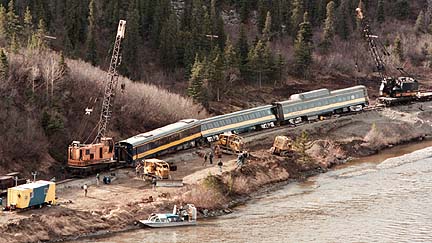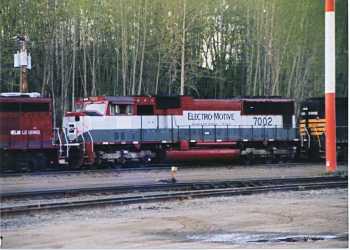1997 News Archive
Fairbanks
Daily News-Miner article: Locomotive #3021 sold for Bed and Breakfast
Fairbanks Daily News-Miner September 13, 1997
Six tank cars with jet fuel derail at yard
No one hurt, nothing spilled
By JOLIE LEWIS
Six tank cars carrying jet fuel derailed
without spill or injury early Friday morning in the Alaska Railroad yard.
A problem with the train or track apparently
caused the derailment, in which two of the cars toppled into the dirt,
breaking railroad ties and disfiguring the tracks. The derailed cars were
visible from the Johansen Expressway where it passes above the tracks near
Peger Road.
Chief Engineer Tom Brooks said the
Alaska Railroad Corp. hasn't finished investigating the derailment but
that preliminary information cleared the crew of any blame. Three people
were in the locomotive of the 62-car train.
"There's marks on the switch to indicate
the wheels climbed on the switch," he said. "so the direction of our investigation
is at the interface between the wheels of the cars and the switch." John
Heater, the railroad's trainmaster, said one of the tank cars apparently
started to go down the wrong track rather than switching as it was supposed
to. Alaska Railroad employees were draining the tank cars, which weigh
263,000 pounds when filled, on Friday afternoon before removing them from
the tracks and completing the investigation.
"Right now the most important thing
to us is to get them off-loaded safely without spilling a drop," Heater
said. "Until we get that taken care of we're kind of stymied on rooting
around and seeing what we have." Brooks said he expected the area would
be cleaned up by this morning, with total repairs costing about $50,000.
"The unknown is how badly the tanks cars are damaged."
Two secondary tracks were damaged.
The main track appeared intact, though the two fallen tank cars that tipped
about 45 degrees were only inches from it.
"The derailment happened in a place
where we can work around it with reasonable ease, so we don't expect delays...
passenger or freight," Brooks said. Two arrivals and two departures were
scheduled Friday.
The train was headed south with MAPCO
jet fuel from the North Pole refinery when the cars derailed at 5 a.m.
Heater said the train's other 56 cars were expected to reach Anchorage
on time.
The train traveling through the switch
at about 9 miles per hour. The tank cars derailed with such force that
the bottom valve was sheared from one of the tanks containing 20,000 gallons
of fuel. But these tank cars, built in the 1980s and 1990s were designed
to withstand some grinding.
Brooks said that should any fuel have
leaked, the railroad has a spill response plan in place.
A 1990 derailment near the Dunbar station,
40 miles south of Fairbanks, spilled 100,000 gallons of fuel. It was an
incident Brooks said the Alaska Railroad works "very hard to avoid repeating."
Reprinted with permission of the
Fairbanks Daily News-Miner
View
article in Fairbanks Daily News-Miner (with photograph)
Memo from Bill Sheffield regarding the SD70MAC purchase:
September 10, 1997
To: ARRC Employees
From: Gov. Bill Sheffield President & CEO
Subject: New Locomotives
The Railroad Board of Directors authorized the purchase
of eight new state-of-the-arts locomotives from the Electro-Motive Division
of General Motors Corporation at their meeting in Fairbanks today. The
purchase is going to have far-reaching effects on the Alaska Railroad,
its customers and employees. I want to keep you informed of the process
every step of the way.
The new locomotives will improve service to our customers
and reduce operating costs. Each of the new locomotives cost about $1.9
million. Delivery is scheduled for early 1999.
Continuing to patch up our old locomotives is not
consistent with the Railroad's philosophy. We're in this for the long run
-- we are committed to providing quality transportation services to Alaska
for at least another 75 years -- and this investment clearly demonstrates
that commitment.
I have appointed a task force of Railroad employees
to coordinate the many changes that will be made over the next few years.
Included in that group is Byron Henshaw, Rich Carter, Wes Rogers, Evan
McKinney, Tom Cannon, Marge Doughty, John Kincaid, Pat Shake, and Jerry
Anderson. This group will ensure that the experience and ideas of all Railroad
employees are hear.
We have been studying options for updating our locomotive
fleet for the past several months. The results of this study, which included
on-site testing of new locomotives this summer, shows that the Railroad
can reduce its fleet from 50 locomotives to about 30 locomotives. Our newest
locomotive was built in 1985 and the oldest built in 1951. We spend about
$7 million annually to operate and maintain this fleet of locomotives,
which uses fifty-year-old technology.
The new 4,000 horsepower locomotives utilize state-of-the-arts
technology, which improves reliability and tractive effort. Each of the
new SD70MACs will pull more than twice the tonnage that can be pulled by
one of the locomotives currently in use on the Alaska Railroad. Similar
units have been in service in the Lower-48 for the past five years.
The power of these units is amazing. Where now it
takes six locomotives to pull a train, with the new locomotives it will
take only three. New technology increases fuel efficiency of the engine
and lowers its emissions. Both of those facts mean it is good for the environment.
This purchase represents the first phase of the transition
to a new locomotive fleet. The transition, which will be completed over
the next five years, calls for the purchase of an additional eight SD70MACs.
As new units are received, the existing units will be sold.
I hope you are as excited as I am about what the
future holds for the Railroad. The purchase of these locomotives represents
a solid step toward a solid future.
(Thanks to Randy Thompson for forwarding this memo
to this web page)
September 10, 1997 News release:
The Board of Directors of the Alaska
Railroad Corp authorized the purchase of 8 new state of the art SD70MAC
locomotives from the Electro-Motive Division of General Motors at their
meeting in Fairbanks on Wednesday, September 10th. Delivery is scheduled
for early 1999. This purchase represents the first phase of the transition
to a new locomotive fleet. The transition, which will be completed over
the next five years, calls for the purchase of an additional 8 SD70MACs.
All units will have distributed power and positive train control and will
most likely carry an adaptation of the blue/gold paint scheme.
View
article in Fairbanks Daily News-Miner
May 18, 1997 - Passenger Train Derailment
An iron rail rolled over Sunday afternoon and caused one
of the largest passenger train derailments. Only the lead locomotive and the
last passenger car at the end of a 12 car train didn't derail. One locomotive
and nine passenger cars fell sideways off the track. Fortunately, no one was
injured. However, the incident closed the track for four days.

Photo by Mike Mathers
May 1997 - "Try Before You Buy" Program
The ARRC has two SD-70Ms (7002 and
7004) for test and possible lease. The SDs will help the ARRC decide whether
to go after SDMACs or SD40-3s (with 3600HP prime movers and steering trucks
from RESCAR). Currently, they are assigned to the gravel train between
Palmer and Anchorage. Also on site are two Helm Leasing GP-40-3s with Computer
Logic Control (4400 and 4401) and two National Rail Equipment GP-20s.

Photo by Jeff Childs

Oil train EMDX 7002 south with EMDX 7004 at Denali Park Depot
Photo courtesy of Randy Thompson, 8/12/97

Oil train EMDX 7002 south with EMDX 7004 (SD70) and GP40 #3016 in Denali
Park.
Photo courtesy of Randy Thompson, 8/14/97
Railroad Receives $10 Million Grant
The Alaska Railroad will use a $10
million federal grant announced this week to replace about 60,000 ties
and install locomotive control systems that prevent train collisions. The
anti-collision system combines digital communications, computer-aided dispatching
and a global positioning system to track train movement, said Scott Banks,
railroad spokesman. Alaska's state-owned rail system will be one of the
first nationwide with the high-tech system. The new network should also
increase safety for track crews making repairs during busy summer months.
Alaska Railroad managers decided to use $4 million from the grant for the
new high-tech equipment, Banks said, because they believe the Federal Railroad
Administration will someday require the system on all railroads.
Back
The information on this page was last updated
December 28, 1997


